Taking Care of Your Hands
By Lauren Farneth, MS, OTL: Advanced Occupational Therapist at University of Maryland Medical Center
 You use your hands to complete a wide range of activities every day, like brushing your teeth, preparing food, and participating in leisure activities. This requires fine motor control, dexterity, grip strength, and coordination. These hand functions can be affected after surgery for a variety of reasons, including a general decline in strength or fluid retention causing your hands to swell. It is important to address these issues both before and after surgery so you can be as functional and independent as possible.
You use your hands to complete a wide range of activities every day, like brushing your teeth, preparing food, and participating in leisure activities. This requires fine motor control, dexterity, grip strength, and coordination. These hand functions can be affected after surgery for a variety of reasons, including a general decline in strength or fluid retention causing your hands to swell. It is important to address these issues both before and after surgery so you can be as functional and independent as possible.
Being ill and waiting for an organ transplant can affect your overall hand function. It is important to keep your hands strong before having surgery, which will make it easier for you to regain function after surgery. After a transplant surgery there are many parts to recovery. While you work on bigger parts, like getting out of bed for the first time and walking, or regaining your overall strength and endurance, it is easy to overlook some of the smaller parts, such as your hands. It is very important to take care of your hands both pre and post-operatively.
It is not uncommon to retain fluid after an invasive surgery related to kidney failure, especially if you have been immobilized for a period of time. It is also possible to have swelling before surgery due to poor circulation, poor nutrition, or vascular problems. The hands and fingers often become swollen, making it harder to bend the joints and difficult to complete fine motor tasks, such as holding a fork or opening a tube of toothpaste. The following are ways to help reduce swelling, also known as edema, in the hands and fingers:
- Keep your arms elevated on pillows when you are lying in bed or sitting up in a chair. Your hand should be higher than your heart.
- Pump your fingers in and out, making a fist and then opening, several times throughout the day to keep the fluid moving.
 Wear compression gloves. These can be provided by a healthcare professional, or may be available at local drug stores or pharmacies. Be sure to monitor the skin on your hands and fingers for signs of irritation or poor circulation (fingertips turning cold or changing color).
Wear compression gloves. These can be provided by a healthcare professional, or may be available at local drug stores or pharmacies. Be sure to monitor the skin on your hands and fingers for signs of irritation or poor circulation (fingertips turning cold or changing color).- Do not wear rings, tight bracelets, or clothing with tight sleeves/elastic wrist cuffs.

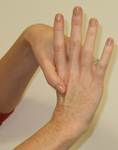 Perform a gentle finger and hand massage to manually move the fluid, starting at your fingertips and massaging towards the base of your hand. Keep your arm elevated so gravity can assist moving the fluid downward. Be sure to use lotion to avoid friction.
Perform a gentle finger and hand massage to manually move the fluid, starting at your fingertips and massaging towards the base of your hand. Keep your arm elevated so gravity can assist moving the fluid downward. Be sure to use lotion to avoid friction.
Keeping your hands strong prior to surgery will make this easier to regain your strength post-operatively. It is important to keep your hands strong so you can be functional and complete simple daily tasks, like opening a jar or turning a door knob. There are a variety of tools available to help strengthen your hands, including hand grippers, light weights, squeeze balls, and theraputty. Theraputty is a resistive putty, ranging in colors based on the level of resistance. It may be provided by a healthcare professional, such as an occupational therapist, or is available to purchase online. If theraputty is not available, you can use Silly Putty or Play-Doh. The following are example of exercises to help strengthen your hands using putty:
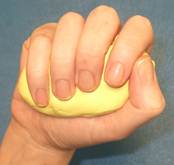 Squeeze putty in hand using your thumb and all fingers, as if making a fist.
Squeeze putty in hand using your thumb and all fingers, as if making a fist.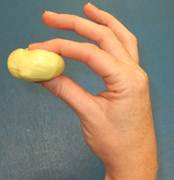 Pinch putty between thumb and fingertip of index finger, then thumb and fingertip of middle finger, and so on for all fingers.
Pinch putty between thumb and fingertip of index finger, then thumb and fingertip of middle finger, and so on for all fingers.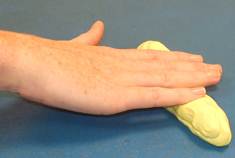 Place putty on hard surface and roll back and forth using all of your fingertips.
Place putty on hard surface and roll back and forth using all of your fingertips.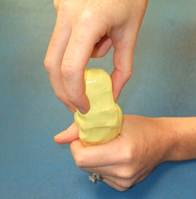 Hold the putty in one hand. Using the thumb, index, and middle fingers of the opposite hand pull putty apart.
Hold the putty in one hand. Using the thumb, index, and middle fingers of the opposite hand pull putty apart.
Hand grippers are another great way to help strengthen your fingers and hands. They generally require more strength, so it is best to begin with squeeze balls or theraputty before using a hand gripper. There are a variety of hand grippers and all range in level of resistance. Below are examples are two common types: a solid gripper to be used with the whole hand, and a digit gripper to be used by individual fingers. These may be provided by a healthcare professional, or may be available at a local sporting goods store.
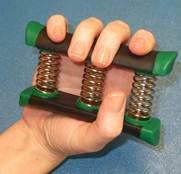
Regardless of what tool you may use to help strengthen your hands, the important thing to remember is to keep your hands moving and active both before and after surgery so you can be as independent and functional as possible!